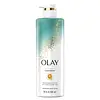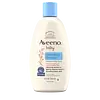What's inside
What's inside
 Key Ingredients
Key Ingredients

 Benefits
Benefits

 Concerns
Concerns

 Ingredients Side-by-side
Ingredients Side-by-side

Water
Skin ConditioningPetrolatum
EmollientSodium Trideceth Sulfate
CleansingSodium Chloride
MaskingCocamidopropyl Betaine
CleansingParfum
MaskingTrideceth-3
EmulsifyingNiacinamide
SmoothingOryza Sativa Bran Extract
Skin ConditioningSodium Citrate
BufferingGuar Hydroxypropyltrimonium Chloride
Skin ConditioningSodium Benzoate
MaskingXanthan Gum
EmulsifyingGlyceryl Oleate
EmollientCitric Acid
BufferingDisodium EDTA
Sodium Hydroxide
BufferingAcrylates/C10-30 Alkyl Acrylate Crosspolymer
Emulsion StabilisingMethylchloroisothiazolinone
PreservativeMethylisothiazolinone
PreservativeCI 19140
Cosmetic ColorantCI 17200
Cosmetic ColorantCeramide AP
Skin ConditioningWater, Petrolatum, Sodium Trideceth Sulfate, Sodium Chloride, Cocamidopropyl Betaine, Parfum, Trideceth-3, Niacinamide, Oryza Sativa Bran Extract, Sodium Citrate, Guar Hydroxypropyltrimonium Chloride, Sodium Benzoate, Xanthan Gum, Glyceryl Oleate, Citric Acid, Disodium EDTA, Sodium Hydroxide, Acrylates/C10-30 Alkyl Acrylate Crosspolymer, Methylchloroisothiazolinone, Methylisothiazolinone, CI 19140, CI 17200, Ceramide AP
Water
Skin ConditioningGlycerin
HumectantCocamidopropyl Betaine
CleansingSodium Lauroamphoacetate
CleansingCoco-Glucoside
CleansingAvena Sativa Kernel Flour
AbrasiveSodium Chloride
MaskingHydroxypropyl Starch Phosphate
Acrylates/C10-30 Alkyl Acrylate Crosspolymer
Emulsion StabilisingCitric Acid
BufferingCaprylic/Capric Triglyceride
MaskingSodium Benzoate
MaskingGlyceryl Oleate
EmollientGuar Hydroxypropyltrimonium Chloride
Skin ConditioningGlycol Distearate
EmollientSodium Hydroxide
BufferingGlyceryl Stearate
EmollientPanthenol
Skin ConditioningCeramide NP
Skin ConditioningAvena Sativa Kernel Extract
AbrasiveWater, Glycerin, Cocamidopropyl Betaine, Sodium Lauroamphoacetate, Coco-Glucoside, Avena Sativa Kernel Flour, Sodium Chloride, Hydroxypropyl Starch Phosphate, Acrylates/C10-30 Alkyl Acrylate Crosspolymer, Citric Acid, Caprylic/Capric Triglyceride, Sodium Benzoate, Glyceryl Oleate, Guar Hydroxypropyltrimonium Chloride, Glycol Distearate, Sodium Hydroxide, Glyceryl Stearate, Panthenol, Ceramide NP, Avena Sativa Kernel Extract
Ingredients Explained
These ingredients are found in both products.
Ingredients higher up in an ingredient list are typically present in a larger amount.
Acrylates/C10-30 Alkyl Acrylate Crosspolymer is a synthetic polymer. It is used to thicken and improve the texture of products. Due to its properties, it can prevent water and oil ingredients from separating.
Citric Acid is an alpha hydroxy acid (AHA) naturally found in citrus fruits like oranges, lemons, and limes.
Like other AHAs, citric acid can exfoliate skin by breaking down the bonds that hold dead skin cells together. This helps reveal smoother and brighter skin underneath.
However, this exfoliating effect only happens at high concentrations (20%) which can be hard to find in cosmetic products.
Due to this, citric acid is usually included in small amounts as a pH adjuster. This helps keep products slightly more acidic and compatible with skin's natural pH.
In skincare formulas, citric acid can:
While it can provide some skin benefits, research shows lactic acid and glycolic acid are generally more effective and less irritating exfoliants.
Most citric acid used in skincare today is made by fermenting sugars (usually from molasses). This synthetic version is identical to the natural citrus form but easier to stabilize and use in formulations.
Read more about some other popular AHA's here:
Learn more about Citric AcidCocamidopropyl Betaine is a fatty acid created by mixing similar compounds in coconut oil and dimethylaminopropylamine, a compound with two amino groups.
This ingredient is a surfactant and cleanser. It helps gather the dirt, pollutants, and other impurities in your skin to be washed away. It also helps thicken a product and make the texture more creamy.
Being created from coconut oil means Cocamidopropyl Betaine is hydrating for the skin.
While Cocamidopropyl Betaine was believed to be an allergen, a study from 2012 disproved this. It found two compounds in unpure Cocamidopropyl Betaine to be the irritants: aminoamide and 3-dimethylaminopropylamine. High-grade and pure Cocamidopropyl Betaine did not induce allergic reactions during this study.
Learn more about Cocamidopropyl BetaineGlyceryl Oleate is the ester of glycerin and oleic acid. This ingredient is mainly an emollient and emulsifier.
Emollients soften and hydrate the skin by creating a thin film on top to trap in moisture. As an emulsifier, glyceryl oleate helps stabilize formulations by preventing ingredients such as oil and water from separating. According to a manufacturer, this ingredient helps helps thicken water-in-oil formulations, shower gels, and hair shampoos.
In some products, this ingredient may be used as a fragrance / perfuming ingredient. The scent of this ingredient is described to be "waxy".
Glyceryl oleate is created from oils rich in oleic acid, such as peanut oil and olive oil.
This ingredient may not be malassezia folliculitis safe.
Learn more about Glyceryl OleateThis ingredient is derived from guar gum.
It is a conditioning ingredient, meaning it helps soften skin and hair.
Sodium Benzoate is a preservative. It's used in both cosmetic and food products to inhibit the growth of mold and bacteria. It is typically produced synthetically.
Both the US FDA and EU Health Committee have approved the use of sodium benzoate. In the US, levels of 0.1% (of the total product) are allowed.
Sodium benzoate works as a preservative by inhibiting the growth of bacteria inside of cells. It prevents the cell from fermenting a type of sugar using an enzyme called phosphofructokinase.
It is the salt of benzoic acid. Foods containing sodium benzoate include soda, salad dressings, condiments, fruit juices, wines, and snack foods.
Studies for using ascorbic acid and sodium benzoate in cosmetics are lacking, especially in skincare routines with multiple steps.
We always recommend speaking with a professional, such as a dermatologist, if you have any concerns.
Learn more about Sodium BenzoateChances are, you eat sodium chloride every day. Sodium Chloride is also known as table salt.
This ingredient has many purposes in skincare: thickener, emulsifier, and exfoliator.
You'll most likely find this ingredient in cleansers where it is used to create a gel-like texture. As an emulsifier, it also prevents ingredients from separating.
There is much debate on whether this ingredient is comedogenic. The short answer - comedogenic ratings don't tell the whole story. Learn more about comegodenic ratings here.
The concensus about this ingredient causing acne seems to be divided. Research is needed to understand if this ingredient does cause acne.
Scrubs may use salt as the primary exfoliating ingredient.
Learn more about Sodium ChlorideSodium Hydroxide is also known as lye or caustic soda. It is used to adjust the pH of products; many ingredients require a specific pH to be effective.
In small amounts, sodium hydroxide is considered safe to use. However, large amounts may cause chemical burns due to its high alkaline.
Your skin has a natural pH and acid mantle. This acid mantle helps prevent harmful bacteria from breaking through. The acid mantle also helps keep your skin hydrated.
"Alkaline" refers to a high pH level. A low pH level would be considered acidic.
Learn more about Sodium HydroxideWater. It's the most common cosmetic ingredient of all. You'll usually see it at the top of ingredient lists, meaning that it makes up the largest part of the product.
So why is it so popular? Water most often acts as a solvent - this means that it helps dissolve other ingredients into the formulation.
You'll also recognize water as that liquid we all need to stay alive. If you see this, drink a glass of water. Stay hydrated!
Learn more about Water